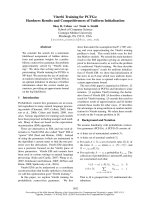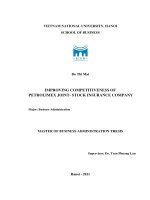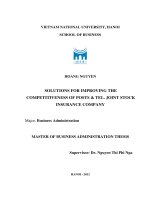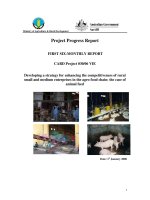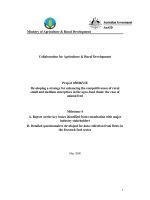Benchmarking competitiveness of cargo airports
Bạn đang xem bản rút gọn của tài liệu. Xem và tải ngay bản đầy đủ của tài liệu tại đây (589.89 KB, 143 trang )
BENCHMARKING COMPETITIVENESS
OF CARGO AIRPORTS
XU YUN JING
(B.Eng.(Hons.), NUS)
A THESIS SUBMITTED
FOR THE DEGREE OF MASTER OF ENGINEERING
NATIONAL UNIVERSITY OF SINGAPORE
2007
ACKNOWLEDGEMENTS
ACKNOWLEDGEMENTS
I would like to express my utmost gratitude to my supervisor Dr. Ng Kien Ming, for
his help and support in this project with his understanding and trust. My sincere
thanks are also presented to all faculties in ISE department, who offered me their
help and care throughout my candidature.
I would also like to thank Ankur for sharing his valuable experience and
encouraging me especially during tough times. Furthermore, I wish to thank many
people from various airports, cargo companies and other industry related
organization for taking their time to provide me helpful advice and suggestions.
Last but not least, I would like to express my appreciations to my friends from all
over the world, and to my parents, who care for me and support me over the years.
i
TABLE OF CONTENTS
TABLE OF CONTENTS
ACKNOWLEDGEMENTS............................................................................................. i
TABLE OF CONTENTS ................................................................................................ii
SUMMARY .................................................................................................................... v
LIST OF FIGURES ......................................................................................................vii
LIST OF TABLES .......................................................................................................viii
LIST OF ABBREVIATIONS ........................................................................................ ix
CHAPTER 1: INTRODUCTION ................................................................................... 1
1.1 Focus of the Study ........................................................................................... 2
1.2
Objectives and Benefits ................................................................................... 4
1.3 Organization..................................................................................................... 7
CHAPTER 2: LITERATURE REVIEW ........................................................................ 9
2.1 Challenges in Airport Study............................................................................. 9
2.2
Air Cargo ....................................................................................................... 10
2.3
Airport Benchmarking ................................................................................... 12
2.4 Asia Airport Studies....................................................................................... 15
CHAPTER 3: RESEARCH METHODOLOGY .......................................................... 23
3.1 Common Benchmarking Methods ................................................................. 23
3.1.1 Quantitative Methods......................................................................... 23
3.1.2 Qualitative Methods........................................................................... 26
3.2
Roadmap for this Study ................................................................................. 28
3.2.1 Developing Benchmarking Framework ............................................. 28
3.2.2 Benchmarking Top Asia Airports...................................................... 32
3.2.3 Competitive Strategy ......................................................................... 34
CHAPTER 4: ASIAN AIRPORT LANDSCAPE ......................................................... 36
4.1 Growth Opportunities and Drivers................................................................. 36
4.1.1 GDP.................................................................................................... 38
4.1.2 Just-in-Time Supply Chain Management .......................................... 38
4.1.3 Liberalization in Aviation Industry.................................................... 40
4.2 Increasing Competition among Asian Airports ............................................. 41
CHAPTER 5: FRAMEWORK FOR BENCHMARKING CARGO AIRPORTS........ 44
5.1 Location ......................................................................................................... 47
5.1.1 Geographical Position........................................................................ 48
5.1.2 Economic Position ............................................................................. 49
5.1.3 Environmental Issues ......................................................................... 51
5.2
Facility ........................................................................................................... 52
5.2.1 Air-Side.............................................................................................. 52
ii
TABLE OF CONTENTS
5.2.2 Terminal............................................................................................. 54
5.2.3 Information Technology .................................................................... 55
5.2.4 Inter-Modal Link................................................................................ 56
5.2.5 Logistics Facilities and Supports ....................................................... 57
5.2.6 Provision for New Facilities .............................................................. 58
5.3
Service Quality............................................................................................... 59
5.3.1 Performance Standard and Monitoring.............................................. 59
5.3.2 Cargo Tracking .................................................................................. 61
5.3.3 Cargo Safety....................................................................................... 61
5.3.4 Cargo Processing Time ...................................................................... 62
5.3.5 Truck Queuing Time.......................................................................... 63
5.3.6 Customs Clearance............................................................................. 64
5.4
Charge ............................................................................................................ 65
5.4.1 Service Charges to Airlines ............................................................... 65
5.4.2 Service Charges to Forwarders .......................................................... 67
5.5
Labor .............................................................................................................. 67
5.5.1 Employee Productivity....................................................................... 68
5.5.2 Labor Cost.......................................................................................... 69
5.5.3 Skills and Knowledge ........................................................................ 69
5.6
Connectivity................................................................................................... 70
5.6.1 Operating Airlines.............................................................................. 70
5.6.2 Air Network ....................................................................................... 71
5.6.3 Concentration of Cargo Forwarders................................................... 72
5.7
Liberalization ................................................................................................. 72
5.7.1 Aviation Policy .................................................................................. 73
5.7.2 Airline Market.................................................................................... 74
5.7.3 Ground Handling ............................................................................... 74
5.8
Competitiveness Index................................................................................... 75
5.9 Validity Test................................................................................................... 79
CHAPTER 6: BENCHMARKING ASIAN CARGO AIRPORTS............................... 81
6.1 Airport Samples ............................................................................................. 81
6.2
Location ......................................................................................................... 83
6.2.1 Geographical Position........................................................................ 83
6.2.2 Economic Position ............................................................................. 85
6.2.3 Environmental Issues ......................................................................... 86
6.2.4 Overall Location Ranking.................................................................. 87
6.3
Facility ........................................................................................................... 91
iii
TABLE OF CONTENTS
6.3.1 Air-Side.............................................................................................. 91
6.3.2 Terminal............................................................................................. 92
6.3.3 Information Technology .................................................................... 92
6.3.4 Inter-Modal Link................................................................................ 93
6.3.5 Logistics Facilities and Support......................................................... 93
6.3.6 Overall Facility Ranking.................................................................... 95
6.4
Service Quality............................................................................................... 96
6.5
Charge .......................................................................................................... 100
6.5.1 Landing Fee ..................................................................................... 100
6.5.2 Warehouse Storage Fee.................................................................... 101
6.5.3 Overall Charge Ranking .................................................................. 102
6.6
Labor ............................................................................................................ 102
6.6.1 Employee Productivity..................................................................... 102
6.6.2 Labor Cost........................................................................................ 103
6.6.3 Skills and Knowledge ...................................................................... 104
6.6.4 Overall Labor Ranking .................................................................... 104
6.7
Connectivity................................................................................................. 105
6.7.1 Operating Airlines............................................................................ 105
6.7.2 Air Network ..................................................................................... 105
6.7.3 Cargo Forwarders............................................................................. 106
6.7.4 Overall Connectivity Ranking ......................................................... 106
6.8
Liberalization ............................................................................................... 107
6.8.1 Aviation Policy ................................................................................ 107
6.8.2 Airline Market.................................................................................. 108
6.8.3 Ground Handling ............................................................................. 108
6.8.4 Overall Liberalization Ranking........................................................ 109
6.9 Competitiveness Index................................................................................. 110
CHAPTER 7: RECOMMENDATIONS AND CONCLUSIONS............................... 114
7.1 Performance Matrix ..................................................................................... 114
7.2
Strategic Implications .................................................................................. 116
7.3
Conclusion ................................................................................................... 118
7.4 Future Work ................................................................................................. 121
REFERENCES ........................................................................................................... 123
APPENDIX................................................................................................................. 130
iv
SUMMARY
SUMMARY
To understand the dynamics of the competition among airports and to stay ahead, the
airport management needs to monitor and improve performance by referencing to
and learning from other organizations. This has emerged as an even more prominent
issue for Asian airports, which enjoy high growth as well as face the challenges
coupled with the opportunities. This study is conducted to formulate a systematic
approach for comprehensive airport benchmarking and to provide insights to the
airport management for performance improvements. This study is focused on air
cargo and Asian airports to contribute to these two less researched areas.
Firstly, a benchmarking framework is constructed for comparing the competitiveness
of cargo airports against each other. A set of factors that are considered influential to
an airport’s competitiveness was identified, and then they were structured into a
hierarchy of 7 core factor groups and an algorithm is formulated to compute the
competitiveness index for the airports under comparison. The framework thus
developed can be applied to airports in different geographical locations and during
different time periods.
Next, the framework is put into practice by benchmarking the top 10 Asian cargo
airports. Scores for each core factor group were computed and rankings of each core
factor as well as overall competitiveness were derived. The benchmarking results
v
SUMMARY
depict a clear picture of the competitive landscape and provide rich information on
the underlying details of each airport’s competitiveness. The competitiveness index
is tested against the conventional airport measures, such as traffic and financial
performance. The relatively high correlation shows our framework is able to reveal
the general perspectives on the competitiveness of airports while offering more
insights into the factors that influence the performance.
An in-depth analysis is conducted to distill best practice and implications for
performance improvement from the platform built upon the framework and
benchmarking results. An innovative competitiveness matrix helps airports
benchmark against the role models that operate in similar environment. Since the
experiences in improving airport performance are more relevant, the chances of
successful best-practice learning are higher.
Key words: Air cargo, airport management, benchmarking, competitiveness, Asian
airports, cargo hub
vi
LIST OF FIGURES
LIST OF FIGURES
Figure 4.1 Asian’s Competition Landscape of Airports................................................ 37
Figure 5.1 Algorithm for Scoring System..................................................................... 78
Figure 6.1 Map of Sample Airports .............................................................................. 83
Figure 7.1 Competitive Matrix of Sample Airports .................................................... 116
vii
LIST OF TABLES
LIST OF TABLES
Table 4.1 Asia Airports in the Worldwide Top 30 Cargo Airports ................................ 42
Table 5.1 Summary of Seven Core Factors................................................................... 75
Table 6.1 Airport Samples............................................................................................. 82
Table 6.2 Geographical Location Index........................................................................ 84
Table 6.3 Rankings of Location Category .................................................................... 87
Table 6.4 Detailed Rank and Score for Core Factor - Location.................................... 90
Table 6.5 Rankings of Facility Category ...................................................................... 96
Table 6.6 Rankings of Service Quality ......................................................................... 97
Table 6.7 Cargo Service Performance Standards in Singapore..................................... 98
Table 6.8 Cargo Service Performance Standards in Hong Kong .................................. 99
Table 6.9 Rankings of Charge Category ..................................................................... 102
Table 6.10 Rankings of Labor category ...................................................................... 104
Table 6.11 Rankings of Connectivity Category .......................................................... 106
Table 6.12 Airline Market Share ................................................................................. 108
Table 6.13 Cargo Terminal Operators at Sample Airports .......................................... 109
Table 6.14 Rankings of Liberalization Category ........................................................ 109
Table 6.15 Computing Rank of Bangkok on Location Factor .................................... 110
Table 6.16 Computing Scores on Location Factor...................................................... 111
Table 6.17 Overall Benchmarking Results ................................................................. 113
Table 7.1 Comparison between Hong Kong and Beijing............................................ 118
Table A.1 Data on Catchment Area Population and GDP........................................... 130
Table A.2 Data on Landing Fee and Cargo Storage Fee ............................................. 130
Table A.3 Data on Labor Productivity and Cost ......................................................... 131
Table A.4 Data on Airport Financial Performance...................................................... 131
viii
LIST OF TABLES
LIST OF ABBREVIATIONS
AAT
Asia Airfreight Terminal
ACE
Air Cargo Excellence survey
ACI
Airports Council International
ACCESS
Advance Clearance for Courier and Express Shipments System
ACCS
Air Cargo Clearance System
ACES
Air Cargo EDI System
AFSCA
Asian Freight and Supply Chain Awards
ASRS
Automated Storage/Retrieval System
ATRS
Air Transportation Research Society
CAAS
Civil Aviation Authority of Singapore
CIAS
Changi International Airport Service
DEA
Data Envelopment Analysis
EDI
Electronic Data Interchange
EPIC
Electronic Payment and Invoicing for Cargo
FTZ
Free Trade Zone
HACTL
Hong Kong Airport Cargo Terminals Limited
HKIA
Hong Kong International Airport
IATA
International Air Transport Association
ICAO
International Civil Aviation Organization
IIA
Incheon International Airport
IT
Information Technology
ix
LIST OF TABLES
KLIA
Kuala Lumpur International Airport
KOTI
The Korean Transport Institute
MSC
Multimedia Super Corridor
OLS / COLS
Ordinary / Corrected Ordinary Least Squares
O-D
Origin – Destination
PRD
Pearl River Delta
RFID
Radio Frequency Identification
SATS
Singapore Airport Terminal Services
SFA
Stochastic Frontier Analysis
TFP
Total Factor Productivity
TLI-AP
The Logistics Institute – Asia Pacific
ULD
Unit Load Device
x
CHAPTER 1: INTRODUCTION
CHAPTER 1: INTRODUCTION
The process of benchmarking has been used by private sectors for a long period of
time, but its spread to the airport industry is rather recent. However, the airport
industry is changing rapidly due to the combined influence from air transportation
deregulation, airport privatization and commercialization, airline alliance formation
and strengthening. All these influences have changed industry dynamics and brought
airports into more direct competitions and forced them to think like a business
instead of mere infrastructure providers as traditionally were done. To understand
the dynamics in the competition and stay ahead, the airport management needs to
monitor and improve performance by referencing to and learning from other
organizations. Within the airport industry, cargo business is increasingly becoming
the focal point since global manufacturing has driven up a large demand to transport
goods faster and more safely. Among the regions around the world, Asia particular
bears high expectation as the largest offshore manufacturer which generates vibrant
economic activities. However, despite such attention on Asian airports, they do not
have the necessary tools to measure performance and compare with others in order
to bring themselves to greater heights. This study is exactly targeted to address these
deficiencies and to further the airport benchmarking research with two particular
areas of focus, Asia and cargo.
1
CHAPTER 1: INTRODUCTION
1.1 Focus of the Study
Compared to other regions, the need for benchmarking is more pertinent to Asia,
which attracted attention from all over the world but whose performance is yet to
catch up with its fast growth. In 2003, Asia, particularly China, has achieved 8.5%
and 10.6% growth rate respectively in air cargo, thus leading the world air cargo
industry. Such high growth is expected to sustain in the near term as investor and
consumer confidence remains strong (Boeing, 2004). However, the promising
opportunity may not guarantee success for every airport in the region. To take
advantage of the high air cargo growth, Asia airports need to constantly improve all
aspects of management, quickly respond to the fast changing market, and be aware
of industry trends thus anticipating the emerging opportunities and challenges.
Asia will need to put in a lot of effort to catch up with its counterparts elsewhere
around the world. A quick look at the airport evolution cycle reveals that Asian
airports are still in a very early stage of development as compared to Europe and
North America. U.S. officially deregulated air transportation in 1978. The European
Union launched liberalization in the 1980s. Asia just started the process with many
privatizations still waiting to be carried out. As such, Asian airports are yet to
understand the new rules of the game, and learn the experience and lessons from
American and European airports in order to become more matured players in the
market. However, the good side of being in the early stage is that new market
demands are more likely to shield Asian airports from stagnation and over supply
2
CHAPTER 1: INTRODUCTION
(BCG, 2004). There will be plenty of room for them to explore their own way of
success and for most of the airports to blossom.
Cargo business has intricate differences from the passenger sector and is arguably
more complicated. Historically, cargo has been a complimentary business for
airlines and airports. Only the spare capacities are allocated to cargo usage, and thus
cargo was by no means regarded as a main revenue source. However, with the
astonishing growth in cargo traffic and increasing price pressure from the passenger
sector, airlines and airports realize the significance of cargo business in their overall
performance and have started to focus on cargo market opportunities. On average,
cargo revenue represents 15% of total traffic revenue, with some airlines aiming to
earn well over half of their revenue from this source (Boeing, 2004). More attention
is now shifted towards cargo and the management desires to acquire systematic
means for strategy and operations involving cargo. Such a need in the industry calls
for a closer look at the cargo airport management in order to take advantage of the
emerging opportunities, exploit cargo market and maximize the profitability
involved.
For Asian airports, cargo business has an even more critical role. Among the top 30
airports in terms of passenger traffic, only 6 Asian airports managed to be on the list.
However, when counting cargo traffic, Asia firmly took up 12 seats, with Hong
Kong nearly bypassing Memphis to be the world’s No.1. The stake Asian airports
3
CHAPTER 1: INTRODUCTION
have in the cargo business is high, and so are the rewards. They will enjoy more
benefits if they focus on improving the cargo facility and services.
1.2 Objectives and Benefits
Noticing the fact that there is a lack of systematic approaches for comprehensive
benchmarking of airports, this study first constructs a framework to compare the
competitiveness of cargo airports 1 against each other. The framework developed
will be generic to all cargo airports and thus can be used in geographical locations
other than Asia, and for different time periods. Next, the framework is put into
practice by benchmarking a number of selected Asian airports. The results will
provide information on the airport ranking within Asia and the details of its
competitiveness in all the areas being rated. The framework and benchmarking
results build a platform for the last step, which is to distill best practice and
implications for performance improvements.
The outcome of this study will benefit a number of parties involved in the air cargo
industry. The most direct beneficiary will be the airports under examination. Under
the increasingly fierce competition in the Asia-Pacific region, airports must
constantly be aware of their performances compared to the best practice in the
1
In this report, Cargo Airports refer to both types of airports 1) which are dedicated to cargo transportation only
2) which are for both passenger and cargo, however only the cargo sector is of interest to the context of this
report.
4
CHAPTER 1: INTRODUCTION
region. They also need to understand the best practices over various dimensions in
airport operations in order to craft strategies to enhance its competitiveness. This
study will present an objective comparison and ranking of their performance using
scientific approaches. One prominent advantage this study offers is embedded in the
comprehensive framework which breaks down the performance into a set of core
factors and sub-factors. Such an approach, as opposed to the common general
ranking, gives critical information to perform detailed analysis on the current airport
management and the foundation for suggesting improvement and policy
implications.
Echoing the call for expansion into the lucrative Asian market and taking advantage
of globalization, most air carriers as well as logistics companies are planning to
locate air hubs or expand operations in Asia. The benchmarking results are useful for
such airport service users in a double-fold way. For those who wish to move into
Asia market, they need to choose the airport that provides the best services at the
lowest cost, so as to satisfy the needs of their customers and ensure their own
profitability. In order to capture the growing market and synchronize with the
market trends, they also need to balance the current development status of the airport
with its future growth. The results of air cargo benchmarking in this study will be
very useful to assist them in the decision making. For those who already have some
presence in Asia, the benchmarking results serve as a good evaluation of the airports
they have operations in. Through such measures and analyses, airlines and logistics
5
CHAPTER 1: INTRODUCTION
companies have a better understanding and realistic view of the airport performance
and its competitiveness. Therefore, they can promptly adjust their corporate plan to
capture the opportunities brought about by the airport development, as well as
preempt the threats or disadvantages at their operating airports.
This study provides a very flexible and open answer to which airport is more
competitive. On one hand, through rigorous computation and analysis, the scores for
each sample airport are highly informative and can be off the shelf for executive
decision making. On the other hand, it leaves much room for users to incorporate
their specific interests and needs. Decision makers can take the semi-processed
analysis results as the input to their own analysis and jumpstart in their
company-specific study, instead of collecting raw data from scratch.
Liberalization of air transportation industry and commercialization of airports have
made airport performance a focus for regulatory bodies and investors. Investors are
interested to increase returns on investment and to identify emerging business
opportunities (ATRS 2004, 2005). Government agencies are responsible for
regulating the airport charges and ensuring the health of the industry as well as the
social welfare at large. Aviation industry, different from other traditional industries,
heavily relies on government regulation and monitoring. Governments have a large
stake and high responsibility in the booming of its airports. Therefore it is to their
interest to understand airports’ current performance as compared to others in the
6
CHAPTER 1: INTRODUCTION
region. Besides the efficiency evaluation, this study also provides in-depth analysis
on the influences of managerial strategies, which could provide additional insight on
how to bring airports to a higher competitive level.
1.3 Organization
This report will try to capture the thought process and analytical details of the study
on cargo airports. It is organized in the following manner to present the factual
findings along with the detailed discussions. Chapter 1 introduces the topic and
answers why this particular topic is of interest and benefit to both academia and
industry. It also briefly touches upon the outcome of the study. Chapter 2 reviews the
past works, both on methodology and various issues in the subject area, with the
purpose of informing readers of the state of the art and identifying the area where
this study could contribute its findings and views. Chapter 3 draws a roadmap of this
study that explains the steps we have conducted for data collection and analysis as
well as the methodology used for various tasks. Chapter 4 depicts a comprehensive
description of the airport competitive landscape in Asia. It traces the reasons for
Asia’s high growth, its opportunities and challenges, and provides the background
for the in-depth discussion in the later chapters. Chapter 5 focuses on the theoretical
part of the benchmarking, in which the framework is described in detail. Various
core factors and sub-factors are defined and its measurement, impact on airport
competitiveness and interdependence with other influences are explained. After the
list of factors, we demonstrate a scoring system which synthesizes the contribution
7
CHAPTER 1: INTRODUCTION
from all factors and gives each sample a single score. Chapter 6 puts the sample
Asian airports into the framework for evaluation and comparison. The input data and
results are explained in detail. In Chapter 7, the implications from the benchmarking
results are further discussed. A simple tool, the competitive matrix is introduced,
which gives more insights in drafting strategies for airports to improve performance.
Finally, the chapter concludes the thesis by highlighting the key points.
8
CHAPTER 2: LITERATURE REVIEW
CHAPTER 2: LITERATURE REVIEW
Overall, air transportation is a fairly new industry in Asia and air cargo has an even
shorter history. During the recent years, the industry observes a sharp increase in
market demand and the extremely fast growth in air transportation, which attracted
academic and research communities. However, very few studies have been dedicated
to this area despite the increasing interest among the various parties. In this section,
we will provide an overview of the significant past studies in the areas of airport and
cargo research.
2.1 Challenges in Airport Study
A number of factors should be attributed to the lack of published study on Asian
airports. The first and most prominent factor is the lack of relevant data. The
majority of the airports collect only the general statistics on cargo traffic and facility,
and often without any detailed break-down. Most of them do not have a formal
system to measure its service quality and customer satisfaction. When it comes to
financial figures, different airports follow very different accounting formats and
fiscal year, which causes possible inconsistency in the data. Secondly, there is no
widely recognized methodology or model for measuring airport’s performance.
Thirdly, the management scheme varies drastically across countries, and even for the
same airport, the ownership may have gone through or is going through
commercialization and corporatization. All these changes resulted in different
9
CHAPTER 2: LITERATURE REVIEW
business practices, making it difficult, if not impossible, to compare airports across
different countries over a time period.
If airport comparison has been neglected for the above reasons, even less attention
has been given to air cargo business because historically, air transport was
dominated by passenger business and air freight was often considered as a
by-product of passenger services (Kim and Ye, 2003). There is also a tendency to
mention air cargo issues only at a superficial level in previous studies due to the
complexity and the specific characteristics of cargo business.
2.2 Air Cargo
Despite all the difficulties mentioned above, a few researchers have pioneered the
study on air cargo. This and the following section will provide a comprehensive
review of their works.
From economic and strategic perspective, cargo liberalization is the center of most
of the discussions. Zhang and Zhang (2002a) employed a multi-market oligopoly
model to compare the impact of liberalization on all the cargo carriers and mixed
passenger-cargo carriers. They concluded that unilateral cargo liberalization will
harm mixed carriers of the home country if foreign carriers produce the two outputs
separately. This finding suggested that separation of air cargo and passenger rights
might be fraught with difficulty in Asia due to the dominance of mixed carriers and
10
CHAPTER 2: LITERATURE REVIEW
their heavy reliance on cargo revenue.
The same implication for the Asia market was emphasized in a general discussion of
issues on liberalization of air cargo services in international aviation (Zhang and
Zhang, 2002b). This paper also showed that all-cargo carriers may have different
routing needs than passenger carriers and thus require different sets of air traffic
rights from those needed by passenger carriers.
Kasilingam (1996) discussed in detail the complexity of developing and
implementing air cargo revenue management. This paper highlights the fundamental
difference between cargo revenue management and passenger yield management,
along with their intricate relationship with passenger yield management. The study
is specific to combination air carriers, which have both substantial passenger and
cargo businesses and operate combi fleets. This is the dominant characteristic of
Asian cargo market.
Due to historical differences in air transportation development and business
environment, Asia has developed a unique air cargo system. The Logistics Institute –
Asia Pacific (TLI – Asia Pacific) published a research paper, describing every
element in the entire cargo business chain, and the technical aspects of each part. It
also dedicates substantial sections to Singapore’s air cargo sector, providing a good
background understanding on its industrial landscape (TLI-AP 2000).
11
CHAPTER 2: LITERATURE REVIEW
2.3 Airport Benchmarking
Airport performance benchmarking is a more established research topic in North
America and Europe. U.S. first started airport deregulation and over the last two
decades, a great deal of efforts has been directed to measure the performance of
airports. Gillen and Lall applied Data Envelopment Analysis (DEA) on a panel of 21
U.S. Airports over a five year period for efficiency measurements (Gillen and Lall,
1997). They improved upon the past performance measurements which were
restricted to accounting terms, and constructed performance indices on the basis of
multiple outputs produced by multiple inputs.
The analysis conducted by Sarkis on operational efficiency of major airports is
focused on U.S. airports as well (Sarkis, 2000). But his study evaluated 44 airports
and considered a more comprehensive variable set of inputs and outputs. Kamp et al.
benchmarked German airports with DEA (Kamp et al. 2004). The relative efficiency
of European airports was measured by Pels et al (Pels et al. 2001).
Instead of using direct objective data, Aldler and Berechman collected subjective
data on airport quality defined from airlines’ viewpoint (Aldler and Berechman,
2001). The model determines the relative efficiency and quality of airports, factors
that have a strong effect on the airlines’ choice of hubs. DEA is again chosen as the
key methodology. This study covered 26 airports mainly in Western Europe, North
America and a small part of Asia.
12
CHAPTER 2: LITERATURE REVIEW
At a global scale, only Air Transportation Research Society (ATRS) has conducted
such a wide range performance measurement. The third annual airport
benchmarking report published in 2004 covers 102 airports, among which 27 are
located in the Asia-Pacific region (ATRS 2004). Supported by its members including
top industry and academic experts in all areas of aviation industry, this report can be
regarded as the most comprehensive study in the field. Its framework and
methodology for unbiased and consistent performance comparison is of great value
to research.
Besides academia, airport and cargo industries are extremely interested in evaluating
airports’ performance so as to promote good practice and improve the industry in
general. Three of such performance evaluation campaigns have received wide
recognition and authoritative reputation. This study referred to their evaluation
criteria in constructing the benchmarking framework.
Building on the success of IATA's Global Airport Monitor, IATA and ACI jointly
launched AETRA in December 2003. AETRA 2 is an airport customer satisfaction
benchmarking program involving 66 airports worldwide. It is based on a
self-completion questionnaire that covers all aspects of passengers' on-the-day
2
AETRA is taken from Latin word “aethra” meaning the upper air, clear sky and is not an acronym (AETRA
website).
13
CHAPTER 2: LITERATURE REVIEW
airport experience and is distributed to passengers at the departure gate (AETRA).
In 2005, the Asian Freight and Supply Chain Awards (AFSCA) reached its 19th year
and have been widely regarded as the most authoritative award for the industry in
Asia (Cargo News Asia, 2005). AFSCA listed a set of criteria that captures the
essence of cargo services and is of good reference for performance measurement.
For cargo terminal, the following criteria are considered:
•
Clearly set performance standards and the clear communication of these
standards to the shipper, logistics service provider or airline.
•
Satisfactory and timely resolution of problems should the above standards not
be met.
•
Timely and adequate investment in new terminal infrastructure to meet future
demand.
•
Effective and easy-to- use IT systems.
•
Minimum criteria Over 10,000 tonnes of cargo handled per annum.
For airport:
•
Provision of suitable cargo-related infrastructure.
•
Cost-competitive, cargo-friendly fee regime.
•
Timely and adequate investment in new infrastructure to meet failure demand.
•
Facilitation of air cargo ancillary services, including logistics and freight
forwarding facilities, either on-airport or off-airport.
14



